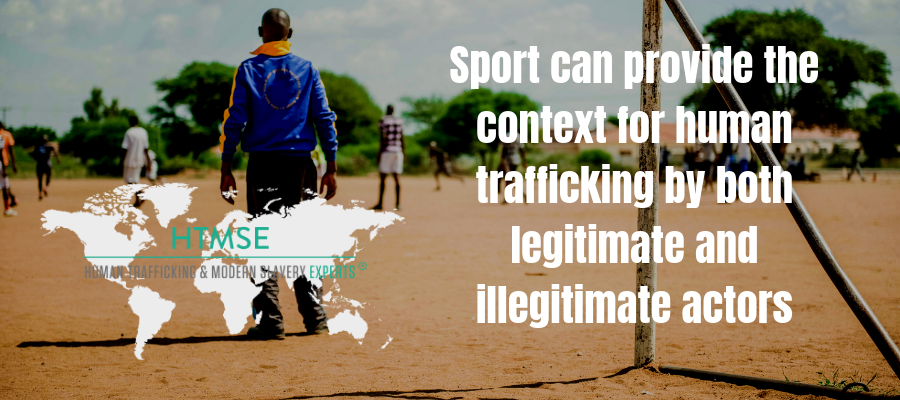
When the words ‘sport’ and ‘human trafficking’ are put together it immediately conjures images of the use of forced labour to construct stadiums or work as hospitality staff at events, or even trafficked sex workers being exploited by organised criminals to make an income on the vast number of people gathering in a particular area. However, human trafficking can be found in other areas of sport also; trafficking of athletes.
Media reports often discuss the issue of trafficking athletes with respect to young boys being trafficked from Africa with the promise of a successful football career. Reports from 2018 placed the value of European football at over 20 billion Euros, with English teams accounting for almost a quarter of this, making it an incredibly alluring industry for those in poverty elsewhere in the world. The victims are often forced to pay a large sum up front before being transported to another country. The end countries are often far away from the major European stadiums that were promised, the destinations often including countries such as Nepal for the ease of acquiring visas. Whilst these issues are often discussed in relation to the football industry, it is in no way limited to football, and can be found in track and field sports, hockey, and camel racing in the Middle East.
A useful distinction when discussing athlete trafficking, and in particular trafficking in the football industry, is the difference between trafficking in football/sport and trafficking through football/sport. This distinction was introduced by Poli (2010, Cited by Esson and Drywood) as follows:
- Trafficking in football/sport: The individual is moved to the a destination country where they have their money and documents confiscated and controlled. They may be forced to sign an exploitative contract which is then further used to control them.
- Trafficking through football/sport: The individual is drawn into paying for transport to a foreign country with the allure of a promising career, though upon arrival they are abandoned.
Generally, most of the recent media cases related to athlete trafficking fit within one of these two distinctions. Whether there is an exploitative contract at the destination or not. However, some criticism of the second category, trafficking through sport, has arisen as to whether the abandonment in the destination country constitutes exploitation for the purposes of the UN definition of human trafficking.
Outside of the illegal exploitation of vulnerable young people from economically deprived backgrounds there have been criticisms of legitimate bodies acting either just outside, or within the deliberately ‘grey’ area of, the rules. These concerns particularly arise over the international transfer of young people between sporting clubs, which under the right conditions could amount to human trafficking, and there have been several high profile cases involving the ‘sale’ of children in a sporting context for the purpose of sexual exploitation. However, the market demands of these usual industry practices has raised concerns that they may operate contrary to the best interests of the children involved more generally. In the context of football, despite the introduction of regulations targeting the international transfer of child players to limit potential cases of trafficking, there have been continued instances of international transfers of children. International transfers, though not always constituting human trafficking, can treat children as commercial commodities. Consequently, these practices are not in the children’s best interests or welfare, especially when considered in respect of the UN Convention of the Rights of a Child. Since these practices are more likely to occur within major legitimate corporate structures, and possibly even within a regulatory framework, isolating instances of human trafficking may be much harder than the cases involving debt bondage and agreements made on false promises
With trafficking of athletes increasingly in the spotlight there has been some criticism of the labour practices involving young athletes taking college sporting scholarships. College sports scholarships have in some ways been likened to modern slavery practices, with athletes being paid what amounts to a very low hourly rate for many hours of their time training and competing. Furthermore, the necessity of their scholarship to their future—many of these athletes coming from more deprived backgrounds— and strict requirements of amateurism can lead to excessive measures of control by scholarship funders and little opportunity for the players to leave their contracts. However, it is unclear from current reporting on the issue whether the exact conditions college sports scholars are under constitute coercion sufficient to amount to modern slavery.
Overall, it is clear that there are many different ways in which human trafficking can manifest in the context of sport. Though there has been no discussion of the links between forced labour, construction, and major sporting events, or the links between sporting events and sexual exploitation, these are important issues to account for. When forced labour and sexual exploitation are also included it is clear that the sporting sector is one at high risk of human trafficking and modern slavery. The conditions for human trafficking can occur under the traditional ‘push and pull’ of economic deprivation and a ‘way out’ and appear congruent with traditional concepts of human trafficking. But human trafficking in sport can also occur within the legitimate structures of sports player transfers, particularly transfers of children, without proper safeguards for their welfare and best interests.
